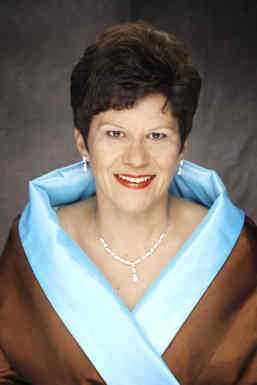Other Links
Editorial Board
- Editor - Bill Kenny
- London Editor-Melanie Eskenazi
- Founder - Len Mullenger
Google Site Search
SEEN
AND HEARD RECITAL REVIEW
Grieg,
Madetoja, Messiaen, Wagner:
Soile Isokoski (soprano), Marita
Viitasalo (piano), Wigmore Hall, London, 21. 2.2008 (AO)
Many years ago, when independent specialist music shops still
existed, there was a salesman with encyclopaedic knowledge and
good taste. When I walked into his shop, he ran over to tell me
about a new recording. “You need to listen to this !” he
insisted. It was Soile Isokoski’s first collection of

Isokoski’s voice is exquisite, but what distinguishes her is her
musicianship. That lithe, agile voice is informed by intelligence
and a genuine sensitivity to a composer’s idiom, as this
performance of Wagner’s Wesendonck Lieder demonstrated. So
often these songs are used as vehicles to display a singer’s
Isolde credentials, for obvious reasons, but the fact remains
that they are art songs in their own terms, not simply blueprints
for the opera. It’s instructive to hear the orchestrations made of
them, especially considering that song wasn’t often orchestrated
in those days. Isokoski’s Wesendonck was therefore a
refreshing change, for she approached them with the
miniaturist detail they deserve. Her voice is big enough that she
can breathe richness into the arching legato. She carried the
long, rising line that is the third strophe of Der Engel,
so it welled up like a swoon. The text describes the angel
lifting the soul heavenwards. Isokoski expressed how the soul must
feel, melting with ecstasy. Here, too, the gentle delicacy with
which she sang the images of childhood in the first verse, brought
out the innocence in this cycle, often missing in more “knowing”
performance. Isokoski can hear, perhaps, the real Mathilde behind
the theatrical Isolde.
Yet, for all the refinement and detail in this performance,
Isokoski never lost touch with the fundamental strength implicit
in the music. The schwellende Pulse beating through
Stehe still ! was presented with firm conviction : the
intensity of the mood matched with steadfast dignity. Similarly,
Isokoski respects the stillness in Im Triebhaus. The plants
are “speaking”, though silent. No need here for hothouse
histrionics on the part of the singer. Significantly, the piano
part is minimal, the voice barely accompanied. These songs
express heightened intensely suppressed emotion : inner atmosphere
is in many ways even more significant than outright drama. Thus
the way isokoski and Viiitasalo built tension up gradually in
Träume was specially moving. Isokoski voice rises up, wie
leere Schäume, floating sensually into the dream-like
transcendence the text refers to. This, truly, was mild und
liese in most distilled form.
In Trois Mélodies, written at the age of 22, Messiaen
already shows his fondness for chromatic colour. I’ve never heard
Isokoski sing Messiaen before, but she has completely absorbed his
idiom. This was magnificent. Each line in Pourquoi? and`La
fiancée perdue begins with repeated words, pourquoi or
C’est, but each word is shaded differently. The songs grow
out of nuance. Simple as they may seem, the singer needs to
understand how each subtle variation unfolds. There’s also no
room for anything less than transparent clarity. These songs were
so lucidly shaped that, hearing them before Wagner enhanced the
sensitivity of Isokoski’s approach to the Wesendonck songs. The
Messiaen songs are much less sophisticated than the Wesendonck
songs, but Isokoski clearly enjoyed their pure, lively spirit,
singing with crisp, clear freshness.
The beautiful juxtaposition of the Messiaen and Wagner songs will
live long in my memory because it was so unusual, but another
feature of this concert was the Leevi Madetoja cycle
Syksy-sarja (Autumn). These songs, too, are intensely
atmospheric. Stabbing ostinato in the piano line creates an image
of windswept seas in Lähtö, The Departure. Isokoski
projects the words Yksin, Yksin (Alone, alone) upwards and
outwards, for the protagonist is setting out for unknown shores.
The poet, Madetoja’s tragic, feminist wife, who used the name L.
Onerva, writes about storms and birds, but it’s clear, from the
last song, Ijät hyrskyjä pain (Forever against the
breakers) that the real turbulence is internal. The refrain
pois, pois itsestäin means, away, away from myself, but
from oneself escape isn’t easy. At the heart of the cycle is
Luulit, ma katselin sua (You thought I was watching you). It’s
sensual and nostalgic at the same time, and very beautiful.
Isokoski breathes lovingly into the final cry Onneni laulun
(my song of joy), each vowel carefully articulated. There are
several recordings of this cycle (recommended version : Juntunen/
Djupsjobacka on Ondine) but Isokoski and Viitasalo are far more
accomplished. For a change, the Wigmore Hall programme notes
weren’t helpful. The reason so few of Sibelius’s songs are in
Swedish is simply because until the very late 19th
century, Swedish was the first language of most educated Finns.
The concert began with the
Grieg Op 48 songs and ended with encores of Wolf and Mozart. They
were lovely, as one would expect from this team of performers.
The real surprise was the final encore – Charles Ives! Ives is
usually performed “American” style, for want of a more accurate
description, but as Susan Graham showed, it is quite feasible to
perform much of his music as mainstream song. Isokoski’s Ives was
warm and affectionate, something that comes over in a good
performance no matter what a performer’s native language might be.
Anne Ozorio
Back
to Top
Cumulative Index Page
